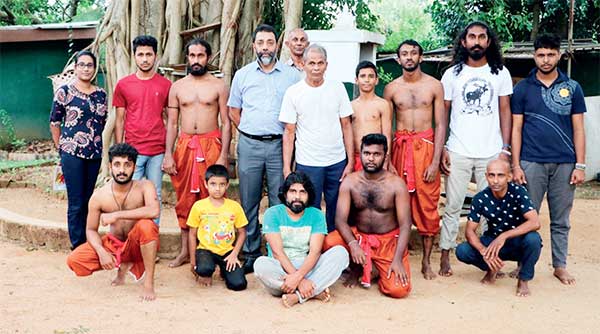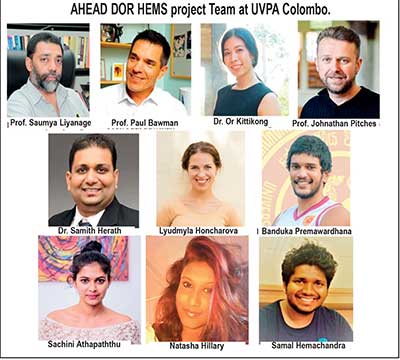Midweek Review
Training actors through Angampora:

Guru Karunapala and his angampora team at Sri Jayawardhanapura University, Gangodavila, Nugedoda. Photo credits Saumya Liyanage 2020.
A project to seek alternative paradigm at UVPA Colombo
By Saumya Liyanage | Lyudmyla Honcharova | Banduka Premawardhana
The concept of ‘actor training’ or ‘performer training’ has developed through the modern era of theatre and dance pedagogies. Western actor training traditions started with the influence of master actor trainer and theoretician Konstantin Stanislavski. As early as the beginning of the 19th century, Stanislavski started his theatrical exploration at his main laboratory known as the Moscow Arts Theatre (MAT) in Russia. His lifelong quest for actors’ arts and his passion for finding a methodology to develop an actor training system continued at the MAT theatre. However, Stanislavski’s actor training system is the most misinterpreted performer training system used in Europe, America, and Asia. As Alison Hodge argues, Stanislavski’s exploration of actors’ arts was more into actors’ inner and outer faculties and further discusses how this interior and exterior interact with each other (Hodge, 2010). Although Stanislavski’s teaching has been variously interpreted and adapted for diverse purposes to train actors, his influence in the modern theatre is still influential in theatre and performance studies (Liyanage 2016).
As Sharon Carnicke believes that Stanislavski wanted his actors to train their ‘selves’ to develop the rounded and full-fledged characters they portray (Sharon Marie Carnicke, 2009). For instance, Stanislavski’s early psychological approaches were influenced by French psychology, and he was continuing his exploration to cater to the emergence of the symbolism and naturalism introduced by the theatre texts of Ibsen, Gorki, Chekov, and others. The need of developing systematic ways to train actors was not an abrupt action that emerged at the MAT Theatre but a purposeful intervention to absorb the modern theatre tradition and the naturalistic dramatic texts that were germinating in early 19th century Europe.
Intercultural performer training

In the late 19th century, theatre practitioners such as Eugenio Barba, John Littlewood, Peter Brook, and Mnouchkine borrowed intercultural performance elements from Asian traditions. However, borrowing and assimilating cultural elements from an alien culture posed several problems. Some critics have questioned the ways that the European avant-garde were looking at cultural ‘others’ in the peripheral world. They argued that the modernist theatre directors’ ideology behind cultural appropriation was constructed within the binaries of ‘culture and savage’ (Gale et al., 2016). Alison Hodge also argues that ‘Asian actor training traditions run the risk of being exoticised or simplistically appropriated by practitioners in the West’ (Hodge, 2010, p. xxi). Jerzy Grotowski has argued that Asian performance traditions are not to be directly used to codify actors’ bodies (Jerzy Grotowski et al., 2015). Rustom Bharucha has extensively discussed the misappropriation, misinterpretations, and mythologisation of Indian dramatic heritage by Western theatre practitioners such as Brook, Schechner and others (Bharucha 1984, P. 2-3).
Angampora
The advances of the Portuguese were resisted by fighters such as King Rajasinghe, the Battle of Mulleriyawa being one such instance. The Kandyan Kingdom resisted the colonizers with the use of angam fighting strategies and techniques. Eventually, the combative art form that received royal patronage through time became the first martial art in the world to be prohibited; the British banned it in 1818 under the governance of Robert Brownrigg.
Suspect practitioners were shot below the knee, while confirmed angampora martial artistes were put to death. angampora was hidden away in various dance forms such as the koti netuma, and more popular styles such as udarata and pahatharata schools of dance. Following Independence, angampora has resurfaced and is becoming popular in Sri Lanka.
Actor Training and Martial Arts
It should be noted that martial arts methodologies are comparatively older and have more defined training structure than actor training. Since first actor training systems evolved in the end of the 19th century in the West, it is not surprising that theatre practitioners were using martial art principles during the creation of their actor training methodologies. Such practitioners were Scott, Copeau, Zarilli, Suzuki, and others. For instance, ‘Scott used tai ji quan as an actor training discipline, was not only a rejection of American actors’ exclusive attention to a psychologically/behaviorally based paradigm of acting, but also an attempt to actualize an alternative paradigm’ (Zarrilli 1995, p. 185). They were paying attention to techniques that strive to develop presence, awareness, and a holistic approach to body-mind work in acting. Many of these actor trainers have referred to Asian martial arts styles.
AHEAD Project 2019-2021
In 2019, Prof. Saumya Liyanage and research assistant to the Faculty of Graduate Studies (FGS) University of Visual and Performing Arts (UVPA) Mr Samal Vimukthi Hemachandra submitted a research proposal titled, ‘Lamp in a windless place: developing an actor training methodology through Sri Lankan martial art’. This research proposal won a competitive grant of Rs. 10 million from the Accelerating Higher Education Expansion and Development (AHEAD) project to pursue a three-year-long actor training exploration. The project was initially influenced by the works of the late Phillip B. Zarrilli, Professor of performance practice and well-known theatre scholar at Exeter University, UK. His research on kalaripayattu martial arts in Kerala India and his years of first-hand experience with kalaripayattu martial arts, kathakali and kuttiyattam dance dramas in India had allowed him to formulate an intercultural actor training system derived mainly from kalaripayattu martial arts in Kerala.
Project Team at UVPA Colombo
Prof. Saumya Liyanage works as the coordinator of the project and its chief investigator. Dr Samith Herath from the Faculty of Visual Arts is the deputy coordinator of the project. His expertise in virtual reality applications and biofeedback technology also help project researchers to capture and monitor actors’ movement works and their biofeedback impulses through cutting edge technology. Natasha Hillary and Sachini Athapaththu work as admin assistants of the project.
In the initial stages of this project, the research team explored the traditional practice of angampora of Guru Karunapala, an 80-year-old angampora master, at his angampora maduwa located in Mirihana, Nugegoda. The field research and embodied practice of angampora are conducted and his legacy of angampora martial arts and indigenous corporeal practices are further explored. Research assistant Lyudmyla Honcharowa explores angampora martial arts with Guru Karunapala while investigating indigenous healing practices of body and mind. Lyudmyla Honcharowa is an actor from Ukraine reading for her MPhil research degree under Prof. Saumya Liyanage’s supervision to explore the connections of actor training methodologies in Europe and Asia. Banduka Premawardhana. also a research assistant of this project, is also reading for his MPhil degree under Prof. Liyanage. He explores how a traditional martial art like angampora could facilitate the training of actors for film and digital medium.
The second phase of the project will start with establishing an actor training laboratory at the Faculty of Dance and Drama, UVPA Colombo. The AHEAD grant supported in renovating an existing rehearsal room into a fully equipped studio space. At the first stage, a group of actors will go through angampora training under supervision of Guru Karunapala to understand and embody angampora principles. During the second phase of laboratory work, actors will be introduced to methods that will be an amalgamation of acting methodologies and angampora martial arts. All stages of actors’ laboratory work are going to be video recorded. Further, actors will be writing personal journals with reflection on the training process which will serve as a source of material for developing a new actor training methodology. In the last stage of the project, a workshop demonstration will be created and performed in front of a selected audience to evaluate the impact of actors and their engagement with the audience. As a part of the project, several angampora groups are chosen for field visits around the country. Project members will also be presenting papers and sharing their findings at international conferences during the project.
Conclusion
The COVID-19 pandemic has adversely affected the activities designed for this actor training project in 2020. The project team was planning to conduct a six-month-long actor training laboratory at the newly renovated studio located at the Faculty of Dance and Drama. However, due to the pandemic situation, these actor training activities have not been able to proceed. In 2021, and with institutional support, the project team is looking forward to launch their laboratory actor training sessions.
UVPA Vice Chancellor Senior Professor Rohana Mahaliyanaarachchi and his office, the Dean of the Faculty of Dance and Drama, Dr Indika Ferdinando and the OTS office director Dr Anusha Jayasiri and her team have extended their fullest support for the project, which is the first actor training project initiated in a State University in Sri Lanka. This project further intends to work with the University Business Linkage (UBL) office and the Director of UBL, Dr Priyeshni Peiris to seek a business model to use this methodology in the creative industry in Sri Lanka and beyond.
Acknowledgements
Authors of this paper wish to thank Himansi Dehigama and Sachini Senevirathne for proof-reading this paper.
About authors: Prof. Saumya Liyanage is a well-known actor and an academic currently working at the Faculty of Dance and Drama, University of the Visual and Performing Arts, Colombo. Lyudmyla Honcharova and Banduka Premawardhana are both working as research assistants to AHEAD DOR HEMS actor training project and they are reading two MPhil degrees exploring martial arts and actor training under the AHEAD grant scheme.
References
Bharucha, R. (1984). A Collision of Cultures: Some Western Interpretations of the Indian Theatre. Asian Theatre Journal, 1(1), 1. https://doi.org/10.2307/1124363
Brecht, B., & Bentley, E. (1961). On Chinese Acting. The Tulane Drama Review, 6(1), 130. https://doi.org/10.2307/1125011
Gale, M. B., Deeney, J. F., Rebellato, D., & Lavery, C. (2016). The Routledge drama anthology and sourcebook : from modernism to contemporary performance. Routledge.
Hodge, A. (2010). Actor training. Routledge.
Jerzy Grotowski, Barba, E., & Brook, P. (2015). Towards a poor theatre. Bloomsbury Methuen Drama.
Ministry of Higher Education, A. O. (2020). Accelerating Higher Education Expansion and Development (AHEAD). https://ahead.lk/
Saumya Liyanage. (2016). Meditations on acting : essays on theory, practice and performance. Dev Publishing.
Sharon Marie Carnicke. (2009). Stanislavsky in focus : an acting master for the 21st century. Routledge.
Tian, M. (1997). “Alienation-Effect” for Whom? Brecht’s (Mis)interpretation of the Classical Chinese Theatre. Asian Theatre Journal, 14(2), 200. https://doi.org/10.2307/1124277
Zarrilli, P. B. (2002). Acting (re)considered : a theoretical and practical guide. Routledge.
Zarrilli, P. B., T Sasitharan, & Anuradha Kapur. (2019). Intercultural acting and performer training. Routledge.